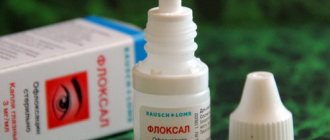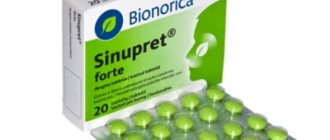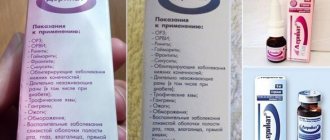Tsipromed drops are an antibacterial drug for topical use in ENT practice and ophthalmology. Active ingredient: Ciprofloxacin.
It is an antibacterial drug from the fluoroquinolone group with bactericidal properties.
The mechanism of bactericidal action is due to inhibition of the bacterial DNA gyrase enzyme, disrupting DNA replication and the synthesis of bacterial cellular proteins.
Tsipromed is active against:
- Gram-negative bacteria: Escherichia coli, Salmonella spp., Proteus spp. (indole-positive and indole-negative strains), Morganella morganii, Citrobacter spp., Klebsiella spp., Enterobacter spp., Yersinia spp., Vibrio spp., Campylobacter spp., Hafnia spp., Providencia stuartii, Haemophilus influenzae, Pasteurella multocida , Pseudomonas spp., Gardnerella spp., Legionella pneumophila, Neisseria spp., Moraxella catarrhalis, Acinetobacter spp., Brucella spp., Chlamydia spp.
- Gram-positive bacteria: Staphylococcus spp., Streptococcus pyogenes, Streptococcus agalactiae, Corynebacterium diphtheriae, Listeria monocitogenes.
It has virtually no toxic effects on the human body.
When applied topically, the period of complete elimination of the product is 8-10 hours. It is excreted unchanged by the kidneys.
Release form Tsipromed:
- eye drops 0.3%: transparent solution from colorless to pale yellow (5 ml in plastic dropper bottles or dark glass bottles complete with a dropper, 1 bottle in a cardboard box);
- ear drops 0.3%: transparent solution from colorless to light yellow (10 ml in plastic dropper bottles or dark glass bottles complete with a dropper, 1 bottle in a cardboard box).
Active substance: ciprofloxacin, 1 ml – 3 mg.
Indications for use
What do Tsipromed drops help with? According to the instructions, eye drops are prescribed in the following cases:
- infectious and inflammatory eye diseases (acute and subacute conjunctivitis, blepharitis, blepharoconjunctivitis, keratitis, keratoconjunctivitis, bacterial corneal ulcer, chronic dacryocystitis, barley);
- infectious eye lesions after injury or foreign bodies;
- pre- and postoperative prevention of infectious complications in ophthalmic surgery.
Indications for prescribing Tsipromed ear drops:
- otitis externa (inflammation of the outer ear);
- postoperative infectious complications;
- prevention of infection after surgery or ear injury;
- removal of a foreign body against the background of tissue damage to the hearing organ;
- acute and chronic inflammation of the middle ear (prescribed, among other things, for otitis media with perforation of the eardrum, when pus breaks through the membrane and comes out).
Instructions for Tsipromed eye drops
The medicine is instilled into the conjunctival sac, 1 or 2 drops. How often this should be done depends on the diagnosis.
Features of treatment with Tsipromed for various eye diseases:
- acute bacterial conjunctivitis, blepharitis - from 4 to 8 times a day for 5-14 days;
- keratitis – 1 drop 6 or more times a day, treatment lasts from 2 weeks to a month;
- anterior uveitis – 1 drop 8-12 times per day;
- acute dacryocystitis, canaliculitis – 6-12 times, chronic forms of these diseases – 4-8 times;
- after injury – 4-8 times a day, the course lasts 1 or 2 weeks;
- after surgery – 4-6 times; depending on the severity of the surgical intervention, the duration of use of the medicine can be from 5 days to a month.
Instructions for use of Tsipromed drops, dosage
Eye drops are instilled into the conjunctival sac of the affected eye. The frequency of instillations depends on the severity of the inflammatory process.
Standard dosages of eye drops, according to the instructions for use of Tsipromed:
- For keratitis - 1 drop at least 6 times a day. If there is a positive effect, the duration of therapy is usually 2-4 weeks.
- For corneal damage caused by Pseudomonas aeruginosa - 1 drop \ 8-12 times a day. The duration of treatment is usually about 2-3 weeks.
- For acute bacterial conjunctivitis, simple, scaly and ulcerative blepharitis - 1 drop 4-8 times a day. The course of treatment is from 5 to 14 days.
- For anterior uveitis - 1 drop of Tsipromed \ 8-12 times a day.
- For acute dacryocystitis and canaliculitis - 1 drop \ 6-12 times a day, for chronic - 4-8 times a day.
- To prevent secondary infection in case of eye injuries, prescribe 1 drop \ 4-8 times a day, for a course of 1 - 2 weeks.
To prevent inflammatory diseases after surgical operations with perforation of the eyeball, 1 drop is prescribed 4 to 6 times a day during the entire postoperative period.
Instructions for Tsipromed ear drops
Before using ear drops, you should sanitize the external auditory canal (rinse and dry the ear canal). Tsipromed is instilled 5 drops into the external auditory canal 3 times a day. The drops must be warmed to body temperature.
After the symptoms of the disease disappear, treatment should be continued for 48 hours.
After instilling Tsipromed, the instructions recommend keeping your head tilted back for 2 minutes. You can place a cotton wool pad in the external auditory canal.
special instructions
If the patient wears soft contact lenses, then he should not use Tsipromed, because the preservative may be deposited in soft contact lenses and have adverse effects on ocular tissue.
You should remove hard contact lenses before instilling the drug and put them back on only after 15 minutes.
When using other ophthalmic drugs, the interval between their administration should be at least 5 minutes.
Side effects
The instructions warn about the possibility of developing the following side effects when prescribing Tsipromed:
- itching, burning, mild soreness and hyperemia of the conjunctiva or in the area of the eardrum, nausea;
- rarely - swelling of the eyelids, photophobia, lacrimation, sensation of a foreign body in the eyes, unpleasant taste in the mouth immediately after instillation, decreased visual acuity, the appearance of a white crystalline precipitate in patients with a corneal ulcer, keratitis, keratopathy, the appearance of spots or infiltration of the cornea, the development of superinfection;
- Allergic reactions, burning and itching sensations in the area of the eardrum may occur.
Contraindications
It is contraindicated to prescribe Tsipromed drops in the following cases:
- hypersensitivity to Tsipromed or any of the components of the drug;
- pregnancy and lactation (breastfeeding);
- viral keratitis;
- children's age (up to 1 year - for eye drops, up to 15 years - ear drops).
Ear drops should be used with caution in acute perforated otitis media.
Overdose
In case of accidental ingestion, there are no specific symptoms. Possible symptoms of overdose are nausea, vomiting, diarrhea, headache, fainting, and anxiety.
It is recommended to ensure sufficient fluid intake in the body, creating an acidic urine reaction to prevent crystalluria.
Analogs
Today, analogues of Tsipromed ear drops are widely represented on the medical market.
"Ciprofloxacin"
"Ciprofloxacin" is an antimicrobial medicine that includes gram-negative microorganisms . The medicine contains active substances, additional hydroxypropionic acid, specialized water.
It should be taken for otitis media, as well as keratitis, anterior uveitis, diseases of mobile skin folds and others.
Do not use if you are particularly sensitive to the elements of the product. And also during pregnancy, breastfeeding and children under one year old.
Depending on the inflammation and the disease process, it is recommended to use the medicine three times a day, four drops.
Side effects include itching and redness.
Do not freeze the product in the refrigerator. Store it at a temperature not exceeding 25 degrees Celsius.
"Tsipropharm"
"Tsipropharm" is a local drug for the treatment of external otitis, postoperative infectious complications and others.
Before putting the drug into the sore ear, clean and dry it thoroughly. Following the dosage, instill five drops three times a day . Before use, warm the bottle in warm water or rub it in your hands. After the course of treatment, instill the drug for another two days to maintain the positive effect.
Side effects include a hypersensitive reaction in the form of itching or burning, pinpoint skin hemorrhages, and blistering accompanied by bleeding.
Do not use the drug on children under 15 years of age.
If you are using additional drops, allow at least 15 minutes between doses .
"Floxal"
"Floxal" is a local remedy used for infectious infections.
In case of ear damage, treatment lasts about two weeks. For external otitis, apply 10 drops into the sore ear once a day . For otitis media - 10 drops twice a day.
While waiting for a new addition to the family and during lactation, the use of drops is not permitted. Since at the moment there is no information about the effect of the medication on fetal development.
The use of the medicine is allowed for children from 1 year of age.
Allergic reactions of the drug are as follows: after use in the ears, itching and redness are possible.
Analogues of Tsipromed drops, price in pharmacies
If necessary, you can replace Tsipromed with an analogue in terms of therapeutic effect - these are the following drugs:
- Ciprofloxacin,
- Rotsep,
- Tsiprolet,
- Phloximed,
- Cipropharm,
- Apox,
- Ciproxol.
When choosing analogues, it is important to understand that the instructions for use of Tsipromed, the price and reviews do not apply to drops of similar action. It is important to consult a doctor and not change the drug yourself.
Price in Russian pharmacies: Tsipromed 0.3% eye drops 5 ml - from 122 to 147 rubles, cost of ear drops Tsipromed 0.3% 10 ml dropper bottle - from 138 to 159 rubles, according to 493 pharmacies.
Store out of reach of children, protected from light, at temperatures up to 25 °C. Avoid freezing.
The shelf life of eye drops is 2 years, after the first opening of the bottle - 1 month. The shelf life of ear drops is 3 years, after the first opening of the bottle – 1.5 months.
Dispensing conditions from pharmacies are by prescription.
How to use drops?
Eye drops should be used daily throughout the course of treatment. The drug should be dripped into each damaged eye, the amount of medication should not be more than 2 drops.
The doctor must individually develop a regimen for taking the drug, which depends on the disease and its severity. To cure blepharitis or conjunctivitis, drops are prescribed for at least 5 days, and the minimum amount of instillation should not be less than 8 times a day. For more severe forms of the disease, the course of treatment can be extended to 14 days. If the drug has not brought benefit by this time, the ophthalmologist should replace the drops to avoid addiction.
If the patient is sick with keratitis, he should instill 1 drop into each affected eye. The number of instillations should not exceed 6. The course of treatment should not exceed 24 days. If the patient's cornea is affected, the drug is dripped one drop 9 times a day, therapy should not exceed 24 days. If the patient suffers from canaliculitis and acute dacryocystitis, the medicine is dripped 1 drop into each eye for 12 days. Number of instillations: 7 times a day. If the disease has developed into a chronic form, treatment must be extended for another 8 days.
Thanks to the action of the antibiotic, the drug is active and eliminates the following types of bacterial infections:
- Escherichia coli.
- Chlamydial inclusions, Brucella and Salmonella.
- Negative strains of the bacterium Proteus mirabilis.
- Vaginal gardnerella, Morgana bacterium.
- Staphylococcal and streptococcal infections.
- Carinebacterium that causes diphtheria.
- Legionella and Neisser's gonococci.
The drug is capable of providing positive dynamics in the treatment of acute and chronic processes in the outer and middle ear, which are accompanied by the release of purulent contents.
It is also possible to prescribe in case of development of a disease of the visual organs:
- Acute and subacute stages of conjunctivitis of bacterial origin.
- Blepharitis and blepharoconjunctivitis.
- Any form of dacryocystitis.
- Formation of chalazion and stye of the upper or lower eyelid.
- Uveitis of the anterior chamber of the eye.
- Ulceration of the corneal layer caused by bacterial infection of the mucous membrane.
- After surgical treatment to prevent the development of secondary infection.
- As a bactericidal agent after removing foreign objects from the eyeball.
The use of Tsipromed eye drops involves the use of different dosages and duration of treatment. This, first of all, depends on the patient’s condition, the clinical picture of the disease, and the stage of the process:
- If the patient is diagnosed with blepharitis (of any type), then instillation of drops can be done up to 8 times during the day (two drops are dripped into both eyes). The course of treatment for the drug is selected by the doctor, in normal cases it is at least a week. Severe forms of the disease allow the use of this medication for half a month.
- Keratitis. This pathology requires long-term use of this dosage form, up to 30 days. The frequency of application should be 6 times during the day (one drop at a time), and equal time intervals between procedures should be observed.
- Uveitis. This disease responds well to treatment with Tsipromed drops; they are used 8 to 12 times a day, at regular intervals, one drop at a time. The criterion for cure for this pathology is the absence of symptoms and clinical manifestations of the disease.
- In case of damage to the corneal layer by Pseudomonas aeruginosa, treatment can last up to 20 days, and the volume of the administered drug is 1 drop, 8 or 12 times a day.
- In case of acute dacryocystitis, the appearance of chalazion or barley, the medicine is prescribed 6 to 12 times a day. Instillations are made into both eyes, one drop at a time.
- To prevent the development of a secondary infection, after removing a foreign body from the eyeball, Tsipromed is used 4 times a day, one drop. The duration of preventive measures can be 2 weeks.
- The rehabilitation period after surgery may be accompanied by the use of this medicine for 30 days. The usual frequency of administration is one drop 6 times a day.
Mode of application
Instillation of eye drops should be carried out according to the instructions:
- Hands should be washed thoroughly under running water using a soap solution.
- Before the procedure, the medicine must be held in the palms of your hands so that it reaches body temperature.
- To carry out the manipulation, it is necessary to move the lower eyelid to the bottom. At the same time, ask the patient to look upward.
- The administration of the drug should not be accompanied by the cannula of the vial touching any part or surface of the visual organ.
- After performing the procedure, the patient needs to close his eyelids and, without changing position, perform light massage movements with his index finger. This will speed up the distribution of the medicine throughout the eye.
We invite you to read: How much does surgery to correct strabismus cost?
Tsipromed ear drops are intended for the treatment of chronic and acute ear infections caused by microorganisms sensitive to ciprofloxacin:
- otitis externa;
- otitis media (acute and chronic);
- prevention at a high risk of infectious complications: before and after surgery, traumatic injury to the ear, removal of a foreign object from the external auditory canal against the background of damage to ear tissue.
You should first rinse and dry the external auditory canal, and warm the drops to body temperature.
To facilitate the instillation procedure, you need to tilt your head or lie on your side on the side opposite the ear being treated. To improve the penetration of drops into the ear canal, slightly pull the earlobe down and back. After instillation, you should not change the position of your head for about two minutes. To keep the drug in the ear, a cotton swab can be inserted into the external auditory canal.
A single dose of the drug is 5 drops in each ear, the frequency of use is three times throughout the day.
After the symptoms of the disease disappear, the drug should be used for another 48 hours. The duration of use of Tsipromed is no more than 14 days due to the possibility of developing a superinfection that is resistant to treatment.
Being one of the strongest antibacterial drugs, Tsipromed eye drops destroy pathogens of keratitis and conjunctivitis of various origins.
Depending on the nature of the disease, Tsipromed drops are used in different ways. For chronic inflammatory processes, the medicine is instilled four to eight times a day, one or two drops into each eye.
If such processes occur in an acute form, the number of instillations is increased to 8-12 times, and the duration of the course can only be determined by the ophthalmologist under whose supervision the treatment is being carried out.
On average, this period ranges from 5 days to two weeks, but there are exceptions:
- In case of diagnosing keratitis in any form, Tsipromed is instilled one drop six times a day or more often, and depending on the severity of the damage to the cornea, the medicine can be used from two weeks to a month.
- For anterior uveitis of any type, instillation is performed 8-12 times a day, but only one drop at a time.
- If there is a possibility of secondary infections (which occurs in the case of injuries to the eye and its appendages), preventive instillation is performed for one to two weeks, one drop 4 to 8 times a day.
- Acute forms of canaliculitis and dacryocystitis require performing the procedure six to twelve times a day, one drop at a time, until symptoms disappear. If the disease has become chronic, instillations are reduced to 4-8 times a day.
Tsipromed is also used to prevent inflammation in patients who have just undergone eye surgery.
In these cases, it is enough to drip one drop of the drug five times a day.
But this must be done throughout the entire rehabilitation period, which, depending on the complexity of the operation, can take from a week to a month.
The main purpose of tsipromed is local treatment of the organs of vision for diseases caused by pathogenic or opportunistic microorganisms.
Such ailments include:
- barley;
- conjunctivitis;
- bacterial ulcer of the cornea;
- blepharitis of various types;
- blepharoconjunctivitis;
- iridocyclitis;
- dacryocystitis;
- uveitis;
- keratitis;
- meibomitis;
- endophthalmitis.
The medicine is also used if treatment with other antibiotic drugs does not produce results, and as postoperative anti-inflammatory prophylaxis after injuries and surgery.
As an option, a person will have to stop using soft contact optics during the course of treatment with Tsipromed.
This is due to the fact that the preservative included in the medicine can leave sediment on optical products, and this in turn can lead to irritation of the mucous membrane of the eyeball and the development of additional diseases.
If you wear hard contact lenses, there are no such restrictions, but the patient can put on such lenses only 15 minutes after instilling Tsipromed. Before using the medicine, lenses must be removed.
Considering that tsipromed can reduce visual acuity, driving a car immediately after using this medicine is not recommended; moreover, the drug has a negative effect not only on the quality and clarity of vision, but also slows down psychomotor functions.
Ear drops are prescribed 5 drops three times a day. The full course of treatment should not exceed 10 days. If positive treatment results cannot be achieved during this time, the doctor will most likely replace Tsipromed with another drug.










